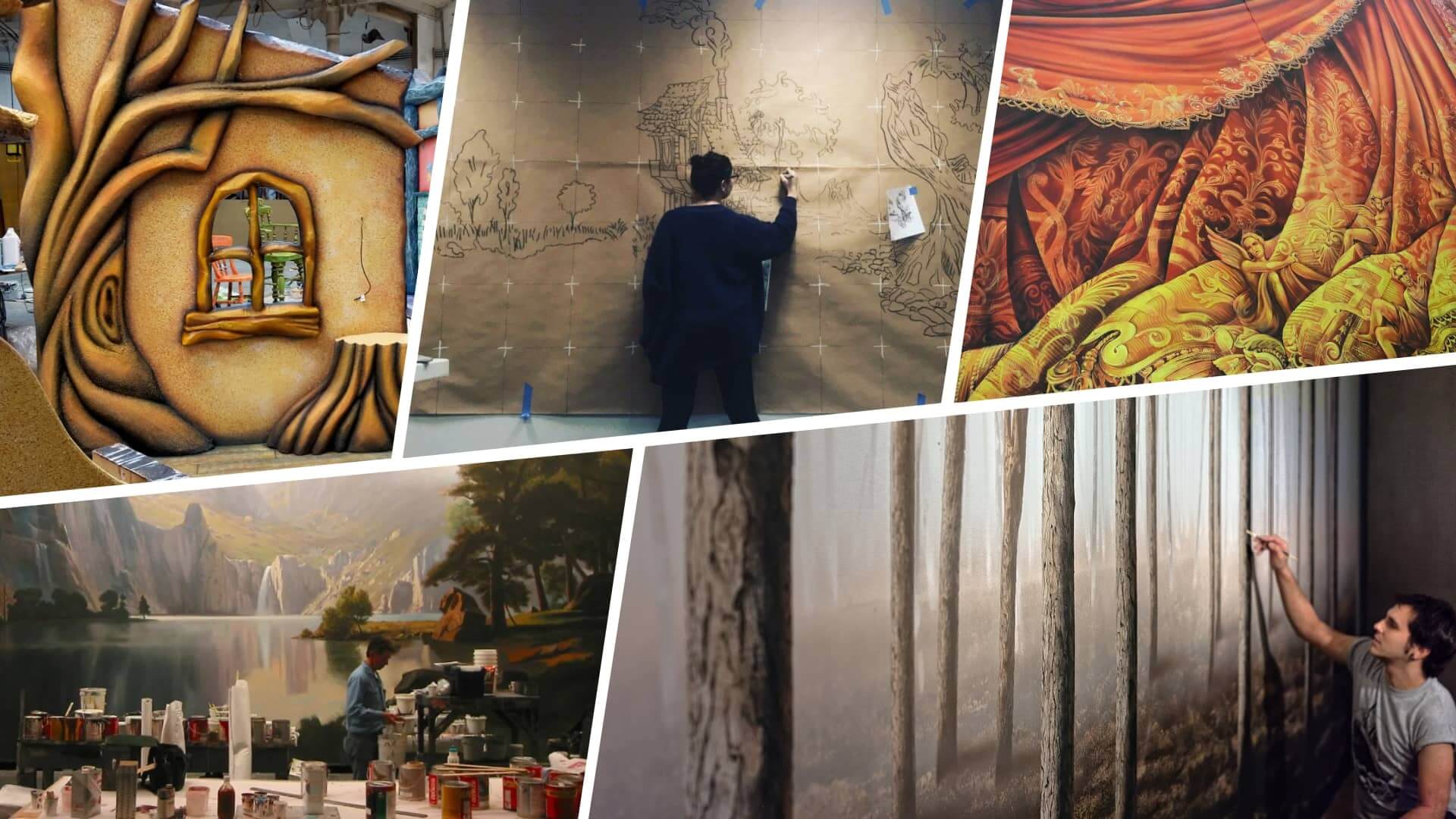M
uch like the skilled hand behind a captivating novel, Scenic Artists are the imaginative forces that paint our visual stories in theater, film, and television. But what is a Scenic Artist? They might not always be in the spotlight, but their work sets the stage — quite literally — for the performances we hold dear. Let’s dive in and uncover the essential role these artists play in our favorite productions.
What is a Scenic Artist?
First, let’s define Scenic Artist
Often perceived merely as the creators of backdrops and props, Scenic Artists are, in fact, pivotal contributors to the film set, breathing life into the director's vision and subtly guiding the audience's emotional responses. Now, let's cut to the chase and define what a Scenic Artist truly is.
SCENIC ARTIST DEFINITION
What is a Scenic Artist in film?
A Scenic Artist is a creative professional who crafts the visual elements of a performance space. They are the masterminds behind the detailed backdrops, intricate props, and immersive environments you see in theater productions, films, and television shows. Their work is not merely about painting a picture—it's about creating a world that can envelop an audience and transport them into the narrative being unfolded.
Now, if we journey back in time, the art of scene painting has its roots in ancient Greek theater, where skēnographía, or "scene-painting," first began. Over centuries, the craft evolved, with each era adding its unique influence—the Renaissance brought perspective, the 19th century introduced realism, and modern times have welcomed digital technologies.
Yet, through all these changes, one thing remains—the Scenic Artist's role in bringing stories to life.
What is a Scenic Artist Responsible For?
- Craft immersive environments
- Design intricate props
- Paint detailed backdrops
Scenic Artist Job Description
What does a Scenic Artist do?
A Scenic Artist is a crucial role that spans multiple performative mediums, such as theatre, film, and television. They are responsible for creating visually stunning and immersive environments that bring stories to life.
Their expertise in color theory, perspective, and texture allows them to transform a blank canvas into a captivating world that enhances the overall storytelling experience.
Conceptualization and Design
These artists are the bridge between the director's vision and the physical world. They begin by studying the script or concept, understanding the mood, the era, the geography, and any other elements that can impact the visual narrative.
They then collaborate with the director and production designer to sketch out ideas and create a cohesive design that serves the story. In our video analysis of production design, we break down the various ways production design is absolutely vital to visual storytelling.Production Design & Filmmaking Techniques · Subscribe on YouTube
Creation of Scenery
Once the concept is approved, Scenic Artists roll up their sleeves and get to work. This involves painting backdrops, crafting props, and building sets.Behind the scenes: Scenic art
They use a variety of techniques — from traditional brushwork to modern digital printing — to create realistic or stylized sceneries. Sometimes, they might work on a grand scale, like creating a bustling cityscape; other times, it could be as intricate as aging a prop to look centuries old.
Collaboration and Adaptation
An artist's work doesn't end with creation. They are part of rehearsals and shoots, ready to make adjustments as needed. They work closely with lighting designers, costume departments, and special effects teams to ensure their work fits seamlessly within the larger production.
Maintenance and Preservation
They also play a crucial role in maintaining the integrity of their work throughout the production. This might involve touch-ups between scenes or ensuring the set withstands the rigors of a performance or shoot.
Scenic Artists
In some cases, particularly in theater, they might also be responsible for striking — the process of dismantling the set after the final curtain call.
Next time you're marveling at a grand castle in a period drama, getting goosebumps from a spooky haunted house in a horror film, or feeling the gritty atmosphere of a crime show's inner-city setting, remember there's a Scenic Artist working tirelessly behind the scenes to create that immersive experience.
Related Posts
Career Path Explained
How to become a Scenic Artist
Embarking on this career path requires a mix of creativity, technical skills, and a deep understanding of visual storytelling. Here's a roadmap to help you navigate your way into this fascinating profession.
Education and Skills
Most Scenic Artists have a bachelor's degree in fine arts, graphic design, or a related field. Some even choose to earn a master's degree for more specialized training. However, it's not just about having a degree.
Aspiring Scenic Artists should be extremely artistic and creative, and possess a vast knowledge of scenic painting techniques, color mixing, texture, and layout.
In this video, you get a behind-the-scenes look at the life of a student working in scenic art in theatre practice.
BA (Hons) Theatre Practice · Scenic Art
Beyond artistic talent, proficiency with different tools and materials, an understanding of safety protocols, and the ability to work under tight deadlines are also crucial. And since Scenic Artists often work as part of a team, good communication and collaboration skills are a must.
Getting Started
Experience plays a significant role in becoming a Scenic Artist. This typically begins with several years of professional experience in theater, film, corporate events, or even theme parks. Start by volunteering or interning at local theaters or film sets, assisting experienced Scenic Artists, or working on student productions. The goal is to gain hands-on experience and learn on the job.
Building a Portfolio
A strong portfolio is a Scenic Artist's calling card. It showcases your skills, creativity, and range as an artist. Include examples of different styles and techniques, from realistic landscapes to abstract designs. Remember to document your work process too, as potential employers often want to see how a piece evolved from concept to completion.
Additional Training and Courses
While a degree and hands-on experience form the foundation, additional courses can sharpen your skills and keep you updated on industry trends.
Look for workshops or short-term courses on scenic painting, prop making, or digital design. Some Scenic Artists also find training in related fields, like carpentry or 3D modeling, beneficial with the rise of virtual production.
Virtual Production
In a world increasingly hungry for visual storytelling, Scenic Artists hold a unique and vital role. With the right education, skills, and experience, you can be the one to paint the worlds we lose ourselves in.
What is a Scenic Artist Paid?
The average Scenic Artist salary
Let's talk numbers. What can a Scenic Artist expect to earn? According to Salary.com, on average, the salary for Scenic Artists in the United States ranges from $30,000 to $70,000 per year. Now, before you start calculating your potential earnings, bear in mind that this figure can fluctuate wildly based on several factors.
Experience plays a significant role. A seasoned Scenic Artist with an impactful portfolio can command a higher salary than a beginner. Location matters too. Scenic Artists in thriving cities like New York or Los Angeles often earn more than those in smaller towns.
The industry you choose also impacts your paycheck. Film and television offer higher pay scales due to larger budgets. With passion, skill, and strategic career choices, Scenic Artists can have a financially satisfying career, doing what they love — painting stories for the world to see.
Finding Jobs
Where to find Scenic Artist jobs
Finding your dream job as a Scenic Artist is a blend of knowing where to look, understanding how to present yourself, and leveraging the power of networking. Here's how you can navigate the job market in this creative field.
Best Platforms for Job Opportunities
Several online platforms help Scenic Artists find new opportunities. Websites like Glassdoor, Indeed, and ZipRecruiter list hundreds of jobs. For theater-focused roles, start with SimplyHired. For specialized listings, try Zippia or Jooble. For film and television opportunities, check Media Match. And don’t forget the Scenic Artists Guild job board.
Preparing a Successful Job Application
Your portfolio is your most powerful tool. Showcase a range of styles and techniques to demonstrate versatility and skill. Include process pictures and sketches to show the evolution of your work.
Highlight relevant experience on your resume, including internships, volunteer work, and professional projects. Mention additional skills like proficiency with digital design tools or carpentry experience.
Tailor your cover letters to each application. Express your passion, explain why you're interested, and highlight how your skills align with the job requirements.
Networking and Professional Organizations
Networking is crucial in the scenic arts. Attend industry events, join online forums, and connect on platforms like LinkedIn. Consider joining organizations like the United Scenic Artists or local guilds for resources and networking opportunities.
Remember, the job search is a journey. Stay patient, keep improving, and make connections. The right opportunity could be around the corner.
In the vast theater of life, Scenic Artists are the unsung heroes who craft the worlds that captivate us. Embarking on this path requires commitment, talent, and strategic career choices, but the joy of creating unforgettable scenes is a reward in itself. In working toward the career of a Scenic Artist, remember to keep refining your craft, stay connected, and let your work narrate the tales that words alone can't encapsulate.
Up Next
Discover more filmmaking roles
A Scenic Artist is the quiet visionary behind the scenes who translates words into vivid scenic visuals. To continue through our series of the various filmmaking roles and positions, you can explore similar jobs like Production Designer, Prop Master, or Art Director. Or you can jump over to our Film Crew Index to browse the entire range of filmmaking roles. Understanding what everyone’s role on a film set is will help make you a better overall filmmaker and a more efficient crew member.
Up Next: Explore more crew positions →
Showcase your vision with elegant shot lists and storyboards.
Create robust and customizable shot lists. Upload images to make storyboards and slideshows.
